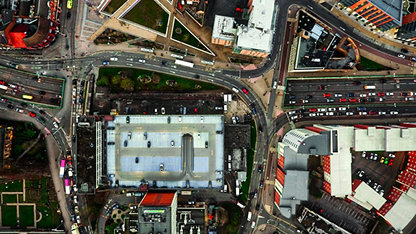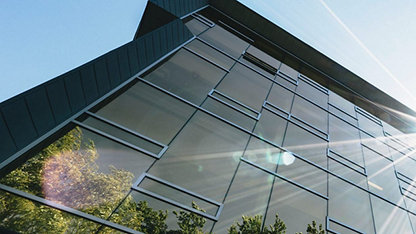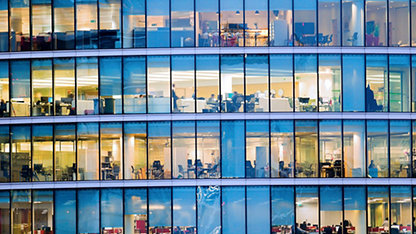Real estate professionals making a living from selling ownership of space are in decline.
The ability to collect and gather insight from behavioural and environmental data is empowering clients to make more informed decisions about the type of real estate they invest in, own and occupy. This means that return on investment is increasingly determined by the range of services accompanying the physical asset: a positive user experience, sustainable development, safety and security.
As a result, there is increasing urgency for our profession to adapt its business models. Indeed, doing so is not only vital for winning business but is also critical if we are to provide a more certain future for generations to come.
Moving from short-term to longer-term thinking
Making money in the real estate industry in future will require longer-term thinking than is currently typical. Investors, owners and occupiers are increasingly demanding buildings that will be able to meet their ongoing, varying needs. Will the building enhance the wellbeing and productivity of occupants? What is the potential impact of the building on the environment throughout its lifecycle? How well protected is the asset from current and future criminal activity?
The gains that people stand to make if these questions are addressed – and the risks to the triple bottom line if we ignore them – are increasingly understood in the market, which is only putting added pressure on our profession to get them right.
How will this approach help with risk management?
Thinking longer-term about the services provided from our built assets to people and society will be critical in ensuring a sustainable future for the built environment sectors. We take a brief look at how this approach will help mitigate economic, environmental and social risks to the profession.
Economic risk
According to a recent report by 100 Resilient Cities, over the next decades, 301 of the world’s leading cities risk losing $4.6tn of their projected GDP to manmade and natural disasters.
“Investors looking at sustainability now are ahead of the curve; they're less likely to be caught out by legislative risks in future.”
RICS Accelerating Investment in Green Finance roundtable
MIPIM, 2019
Sustainable development of our built environments to address these risks is no longer a ‘nice-to-have’. We must consider it within all of our decision-making processes if our profession is to avoid obsolescence and take a leading role in building a future fit for generations to come.
“Profits and purpose are inextricably linked.” – RICS Natural Capital roundtable, MIPIM.
Environmental risk
We are entering a new ecological epoch. To meet the goal of keeping global temperature rises to 1.5 degrees, emissions must halve by 2030. They must halve again to reach the target of zero net emissions by 2050. The results if we don’t tackle the climate agenda now are well documented – they will be catastrophic, not only for the future of our profession, but for the future of our planet.
“The climate will soon force us to incorporate sustainability measures into real estate value, particularly in high risk areas.” – RICS Performance for Value roundtable, MIPIM.
Social risk
As the value of our built assets is increasingly determined by the services they provide to people and society, it will be crucial for our profession to have a much greater focus on creating spaces that improve social value. Examples include enhancing the wellbeing of occupiers, ensuring the building is protected against cyber-attacks and helping to tackle the loneliness epidemic spreading across many societies around the world by creating spaces that encourage the formation of communities. If we don’t, there is a real risk that this role will be filled by professionals from other industries.
“Demonstrating social value is now part of the service we deliver as real estate professionals – it should be part of our brand management.” – RICS Accelerating Investment in Green Finance roundtable, MIPIM.
Why aren’t we moving more quickly?
Changing our approach will enhance the profession in markets around the world and help to ensure a sustainable future, both for the built environment sectors, and the people and societies we serve.
But we aren’t moving quickly enough.
Behavioural change takes time, but with so much to gain, and much to lose, how can we start to implement longer-term strategising?
Regulation
Regulation is one approach. As we get closer to 2030, the need to meet the Sustainable Development Goals will become increasingly urgent. There is a real risk that government will impose legislation that forces the built environment sectors to integrate longer-term thinking into the services that built assets provide to people and society.
“Investors looking at sustainability now are ahead of the curve; they're less likely to be caught out by legislative risks in future.” – RICS Accelerating Investment in Green Finance roundtable, MIPIM.
This provides real incentive for our sector to start looking at this seriously now, so that we’re much more likely to be on the right side of government action.
“According to a recent report by 100 Resilient Cities, 301 of the world’s leading cities risk losing $4.6tn of their projected GDP to manmade and natural disasters.”
Education
Regulation is not the only way to provide incentive. Education is another approach. Explaining the benefits of adopting longer-term thinking to people, businesses and the planet is crucial.
“We need a joined learning approach, across markets and sectors.” – RICS Accelerating Investment in Green Finance roundtable, MIPIM.
Data and technology
Leveraging data and technology will play a huge role in determining whether the real estate industry is able to adapt to these changing demands. Technology is providing us with the tools required to set specific KPI’s about a building’s ability to deliver a value-added service. Software tools can provide intelligence about a building’s carbon and energy performance as well as increase the comfort and productivity of occupiers through lighting and temperature management, tailored to an individual’s personal preferences. As these systems advance, and are increasingly able to communicate with each other, building managers will be able to implement the data collected for its best purpose. Investing in these technologies will become increasingly important to enable our profession to implement longer-term strategising.
“We aren’t simply trying to mimic existing processes to create the same buildings we’ve always created. With technology, we can make existing processes better to create better built environments.” – RICS Accelerating Investment in Green Finance roundtable, MIPIM.
Thinking longer-term about the services provided from our built assets to the people who use them and the environments they take up space in, will be critical for the future of our profession. Doing so will not only ensure sustainable return on investments for professionals working within the built environment sectors but will also ensure a sustainable future for generations to come.


















